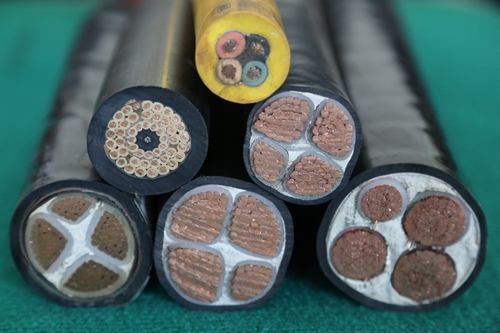
The basic structure of the power cable consists of a core (conductor), an insulating layer, a shielding layer and a protective layer.
The core is the conductive part of the power cable that is used to carry electrical energy and is the main part of the power cable.
The cable core has two kinds of copper core and aluminum core.
The core cross-section has three shapes: circular, semi-circular and fan-shaped.
Three-core and four-core low-voltage cables use fan-shaped cores. Depending on the type and specification of the cable, the core can be made into a single strand or a stranded core.
The stranded core is made up of a single strand and a single strand.
The insulating layer electrically isolates the core from the earth and the cores of different phases to ensure electrical energy transmission, and is an indispensable component of the power cable structure.
1 Oil-paper insulated cable is mainly divided into two types: viscous impregnated paper insulation and non-drip flow.
It is generally used in 3-35KV system.
2 Viscous impregnated paper insulated cable: simple structure, convenient manufacturing, low price, easy to install and maintain, long life.
Not suitable for high drop laying, insulating oil is easy to flow.
3 Non-drip impregnated paper insulated cable: the cost is slightly higher than the adhesive paper insulation, the working life is longer, and the high drop can be laid.
4 Commonly used plastic insulated cables are cables such as polyvinyl chloride, polyethylene and cross-linked polyethylene.
The installation process is simple, the laying and maintenance are convenient, can be adapted to the high drop laying.
And has non-combustibility; the working temperature has a significant influence on the mechanical properties.
Generally used in 6KV and below systems.
It can be applied to high drop placement, good process performance and easy processing.
But it is easy to prolong combustion, heat is easy to deform, and stress cracking is easy.
The cross-linked polyethylene cable allows higher temperature rise, so it allows larger current carrying capacity and good heat resistance.
It is suitable for high drop placement, easy installation and maintenance, and poor resistance to corona and free discharge.
XLPE cables are now more widely used and are suitable for a wide range of voltages.
The rubber insulated cable has good flexibility, is easy to bend, has elasticity, and is suitable for multiple disassembly and assembly lines.
But has poor resistance to corona, ozone, heat and oil, so it can only be used as a low voltage cable.
Power cables of 15KV and above generally have a conductor shield and an insulating shield.
The role of the protective layer is to protect the power cable from external impurities and moisture, and to prevent external forces from directly damaging the power cable.
In order to prevent mechanical damage, electrochemical corrosion and moisture intrusion, the cable core and insulation layer of the power cable have a tight protective layer.
The protective layer structure of the power cable is described by taking the XLPE insulated and PVC sheathed power cable as an example.